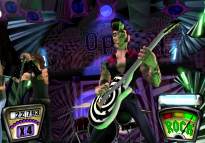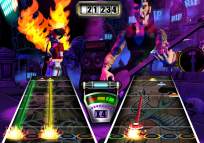Following
up last year's surprisingly successful music game, Guitar Hero II brings
the noise once again with an expanded soundtrack, additional modes of play
and more moves. Like last year's game, the object is to shred notes using
the Guitar controller in time with the notes on the screen. A very cool
career mode lets you play from small bars to concert halls while adding
extra finishing moves and star power to your band. This is a really cool
game with awesome characters, a rocking soundtrack making it one of the
more enjoyable music titles on the PS2 to date.
On the surface, Guitar Hero II seems a
lot like most other music games on the market, but once you strap on the
SG Guitar controller, the experience is transformed into an immersive,
intensely cool game that makes you feel like your onstage in front of a
large audience. The gameplay itself is deceptively straightforward - you
follow the notes on the screen and use the fret buttons on the controller
to hit in time to when they appear. They come down at different speeds in
time to the song, making it important to keep the beat and pay attention
to the backing tracks. At the earlier levels, this is relatively easy, but
later on you need better timing and coordination, since notes come at you
faster and multiple buttons need to be pressed at the same time to create
chords. This is a lot harder than it sounds. Some notes need to be pushed
when they hit your status bar, while others need to be held down to create
a longer note. When you get some practice in and learn a song's rhythms,
you can use the whammy bar to wail and warp the notes. Doing this
increases your score. As you play through the game, you're score will rise
if you hit notes in succession, but drop quickly if you miss them.
Combining multiple notes also increases your score multiplier, which goes
through the roof the better your performance is. Consistently hitting the
notes will rock the crowd, and cause the band's intensity to rise. You'll
hear the cheers and boos of the crowds as well, depending on how you
perform.
Guitar
Hero II's
solo modes are challenging and loads of fun, but the game also lets you
battle it out with another player in multiplayer mode. This requires a
second controller, which can become expensive, but it probably worth it if
you want to have friends over. In
addition, the score will rise if you hit notes in succession, and help you
to move forward in the competitive modes. Combining multiple notes also
increases your score multiplier, which goes through the roof the better
your performance is. Consistently hitting the notes will rock the crowd,
and cause your both your score and ratings to rise. Adding to these cues,
you’ll also hear the cheers and boos of the crowds as you play, which
helps to set the mood for each performance. If you really start doing
well, you’re special Star Power Meter will rise. When the Star Power
meter is filled up, you can implement this special mode for a short time,
and cause your guitarist to perform some super moves that will really rock
the crowd. This can help to increase your score even more and helps you to
achieve super-human score much faster. Learning how and when to implement
these special moves is a key element in beating the songs and unlocking
additional tracks later on.
 Guitar
Hero II includes several modes of play to help anyone go from groupie to
god without much effort. For the uninitiated, a practice training mode is
included which helps you learn the basics. You can then go on and play the
songs individually in the game setting, just be careful since the songs
cut-off prematurely if your meter falls too low and stays there too long.
The game has several levels of difficulty and these play a large role in
the complexity and challenge you'll face. Guitar Hero II starts off simply
enough, but its harder levels throw a lot at you at once. While its
tempting to try out the more advanced songs first, novice players will
probably find themselves quickly overwhelmed by them. Playing the single
player mode is fun in short bursts, but most players will probably get
bored of the same half-dozen songs after awhile. In order to unlock more
tunes, you need to go into the game's Career mode. Here, you can start
(and even name) your band, select your avatar (ranging from a punk to a
classic rocker) and finally your signature guitar (including a v-neck and
the classic Gibson Les Paul.) Your band then hits the stage at a number of
smaller venues such as high school battles of the bands, small bars and
other events. These help to build up your reputation as you master and
beat songs. This helps your band earn money which you can use in the
game's store to purchase additional items such as new moves, extra guitars
and even more songs. Guitar Hero II remains accessible and enjoyable
throughout and the game lets you build up at your own pace, allowing you
to have fun without feeling overwhelmed.
Guitar
Hero II includes several modes of play to help anyone go from groupie to
god without much effort. For the uninitiated, a practice training mode is
included which helps you learn the basics. You can then go on and play the
songs individually in the game setting, just be careful since the songs
cut-off prematurely if your meter falls too low and stays there too long.
The game has several levels of difficulty and these play a large role in
the complexity and challenge you'll face. Guitar Hero II starts off simply
enough, but its harder levels throw a lot at you at once. While its
tempting to try out the more advanced songs first, novice players will
probably find themselves quickly overwhelmed by them. Playing the single
player mode is fun in short bursts, but most players will probably get
bored of the same half-dozen songs after awhile. In order to unlock more
tunes, you need to go into the game's Career mode. Here, you can start
(and even name) your band, select your avatar (ranging from a punk to a
classic rocker) and finally your signature guitar (including a v-neck and
the classic Gibson Les Paul.) Your band then hits the stage at a number of
smaller venues such as high school battles of the bands, small bars and
other events. These help to build up your reputation as you master and
beat songs. This helps your band earn money which you can use in the
game's store to purchase additional items such as new moves, extra guitars
and even more songs. Guitar Hero II remains accessible and enjoyable
throughout and the game lets you build up at your own pace, allowing you
to have fun without feeling overwhelmed.
While Guitar Hero II can be played with
the standard PS2 analog controller, doing this only offers a fraction of
the fun of playing with an axe strapped to your chest. Once your
controller is set up, the game truly comes to life as an immersive,
enjoyable game. The included GS controller is fairly simple to use and
feels like a standard guitar (minus strings, however) but the basic shape
and configuration is decent. The fret buttons are nicely spaced apart,
with the strum bar allowing you a comfortable fit. A whammy bar completes the
package, and makes you feel like you're playing a real guitar, though it's
a bit lighter than a really good one. Using the controller makes things feel quite
intuitive and accessible, and adds to Guitar Hero II's almost immediately
accessible gameplay. It should be easy to pick up and play, and this even
applies to non-musicians who might have never played an instrument before.
The game itself is set up nicely with an easy to understand interface that
shows the notes on the bottom of the screen, while an animated movie shows
your band rocking out above. As you might expect, the song selection in
these types of games plays a huge role in how much fun they are to play.
 Guitar
Hero II's licensed hard-rock and heavy metal soundtrack features an
appealing mix of tracks from classic acts like Van Halen and Motley Crue,
to more recent bands like Artllery Guitar and the Foo Fighters. There's a
good balance between underground and mainstream bands, which gives the
game plenty of variety. There are more than 50 tracks included in the game
and the complexity and challenge of the tracks seems to increase as you
beat older songs. The tracks themselves are easy to hear under your
guitars so you don't have to worry about them being submerged underneath
your fretwork. As you play through the game, you can also go back and
retry other tracks you've already beaten at other difficulty levels, which
makes things more fun. You can definitely feel that a lot of work has gone
into the game, and it's definitely one of the more challenging music
titles on the market. GH II's intuitive controls allow newcomers to jump
in right away, but the more complex songs should challenge veterans as
well. The game's structure is easy to understand and offers players
multiple paths and options to explore, with plenty to unlock and keep you
motivated. An excellent soundtrack is more varied than last year's game,
and the increased levels of avatar customization and unlockable extra
features make the career mode even deeper. While the developers at
Harmonix and Red Octane could have rested on last year's success, they've
made this year's installment even better. Guitar Hero II successfully
builds on the promises of last year's game, and offers a number of
improvements that make it an excellent title that's definitely worthy of
your time and effort.
Guitar
Hero II's licensed hard-rock and heavy metal soundtrack features an
appealing mix of tracks from classic acts like Van Halen and Motley Crue,
to more recent bands like Artllery Guitar and the Foo Fighters. There's a
good balance between underground and mainstream bands, which gives the
game plenty of variety. There are more than 50 tracks included in the game
and the complexity and challenge of the tracks seems to increase as you
beat older songs. The tracks themselves are easy to hear under your
guitars so you don't have to worry about them being submerged underneath
your fretwork. As you play through the game, you can also go back and
retry other tracks you've already beaten at other difficulty levels, which
makes things more fun. You can definitely feel that a lot of work has gone
into the game, and it's definitely one of the more challenging music
titles on the market. GH II's intuitive controls allow newcomers to jump
in right away, but the more complex songs should challenge veterans as
well. The game's structure is easy to understand and offers players
multiple paths and options to explore, with plenty to unlock and keep you
motivated. An excellent soundtrack is more varied than last year's game,
and the increased levels of avatar customization and unlockable extra
features make the career mode even deeper. While the developers at
Harmonix and Red Octane could have rested on last year's success, they've
made this year's installment even better. Guitar Hero II successfully
builds on the promises of last year's game, and offers a number of
improvements that make it an excellent title that's definitely worthy of
your time and effort.
Grade: B+

